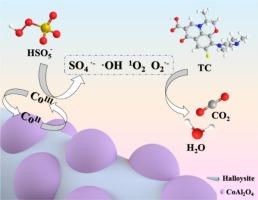Dual role of halloysite nanotubes in the synthesis of the complex with CoAl2O4 and tetracycline degradation
IF 5.8
2区 地球科学
Q2 CHEMISTRY, PHYSICAL
引用次数: 0
Abstract
Halloysite nanotubes (HNTs) served as the support and aluminum source for in-situ synthesizing CoAl2O4/HNTs (CAO/HNTs), which acted as an effective catalyst to activate peroxymonosulfate (PMS) for degrading tetracycline hydrochloride (TC). To achieve the optimal removal performance, various parameters were optimized. The final CAO/HNTs demonstrated a high degradation efficiency of 88 % toward TC within 40 min, which was 1.69 times as high as that of pure CAO. The existence of HNTs made CAO highly dispersed, increasing the number of exposed active sites and the contact opportunities between CAO and TC molecules, which enabled CAO to participate in the reaction more effectively and thus improved the degradation efficiency. Additionally, the formation of Co-O-Al bonds facilitated the growth of CAO into a three-dimensional (3D) spherical structure with more active sites other than the tetrahedral structure on HNTs. In the CAO/HNTs/PMS system, O2•– and 1O2 contributed mostly to the catalytic process. This work not only provides a novel catalyst for the treatment of antibiotic pollution, but also offers an innovative strategy for fabricating functional materials on the basis of chemical composition and morphology characteristics of natural minerals.

高岭土纳米管在与CoAl2O4配合物合成和四环素降解中的双重作用
以高岭土纳米管(HNTs)为载体和铝源,原位合成了co2o4 /HNTs (CAO/HNTs),并作为催化剂激活过氧单硫酸盐(PMS)降解盐酸四环素(TC)。为了达到最佳的去除效果,对各参数进行了优化。最终的CAO/HNTs在40 min内对TC的降解效率高达88%,是纯CAO的1.69倍。HNTs的存在使CAO高度分散,增加了暴露活性位点的数量,增加了CAO与TC分子接触的机会,使CAO更有效地参与反应,从而提高了降解效率。此外,Co-O-Al键的形成促进了CAO生长成具有更多活性位点的三维(3D)球形结构,而不是HNTs上的四面体结构。在CAO/HNTs/PMS体系中,O2•-和1O2对催化过程的贡献最大。这项工作不仅为抗生素污染的治理提供了一种新的催化剂,而且为基于天然矿物的化学成分和形态特征制造功能材料提供了一种创新的策略。
本文章由计算机程序翻译,如有差异,请以英文原文为准。
求助全文
约1分钟内获得全文
求助全文
来源期刊

Applied Clay Science
地学-矿物学
CiteScore
10.30
自引率
10.70%
发文量
289
审稿时长
39 days
期刊介绍:
Applied Clay Science aims to be an international journal attracting high quality scientific papers on clays and clay minerals, including research papers, reviews, and technical notes. The journal covers typical subjects of Fundamental and Applied Clay Science such as:
• Synthesis and purification
• Structural, crystallographic and mineralogical properties of clays and clay minerals
• Thermal properties of clays and clay minerals
• Physico-chemical properties including i) surface and interface properties; ii) thermodynamic properties; iii) mechanical properties
• Interaction with water, with polar and apolar molecules
• Colloidal properties and rheology
• Adsorption, Intercalation, Ionic exchange
• Genesis and deposits of clay minerals
• Geology and geochemistry of clays
• Modification of clays and clay minerals properties by thermal and physical treatments
• Modification by chemical treatments with organic and inorganic molecules(organoclays, pillared clays)
• Modification by biological microorganisms. etc...
 求助内容:
求助内容: 应助结果提醒方式:
应助结果提醒方式:


